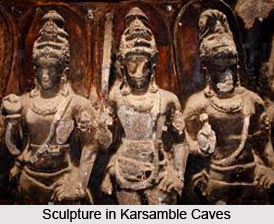 Karsamble Caves are Buddhist rock-cut temples, which were created roughly around 2nd century BC. They are situated in Pune in the Maharashtra state of India. There are almost 37 separate caves, and few of these contain bits and pieces of plaster of white, black and red colour. The Karsamble Caves used to be lavish monasteries pregnant with contemporary artwork of paintings and sculptures. Currently, these historical caves serve as a tourist spot and are visited by a number of people from different parts of the country.
Karsamble Caves are Buddhist rock-cut temples, which were created roughly around 2nd century BC. They are situated in Pune in the Maharashtra state of India. There are almost 37 separate caves, and few of these contain bits and pieces of plaster of white, black and red colour. The Karsamble Caves used to be lavish monasteries pregnant with contemporary artwork of paintings and sculptures. Currently, these historical caves serve as a tourist spot and are visited by a number of people from different parts of the country.
History of Karsamble Caves
The Karsamble Caves were apparently built during the 2nd century BC. The caves were deserted in the late 5th century AD approximately after the port of Chaul degraded and declined. In 1881, H. Cousens discovered the abandoned caves, which were utilised as a refuge by the Indian revolutionary Vasudeo Balwant Phadke.
Architecture of Karsamble Caves
The Karsamble Caves contain numerous structure sculptures and paintings of Buddhist art and served as a luxurious Buddhist monastry. The Karsamble Caves are a set of 37 rock-cut cave structures which is located beside the trade route that was present near Chaul, the ancient port. There are a few more similar types of rock cut caves that are fairly impressive, in similar locations, which are of Buddhist origin. The Karsamble caves are situated at difficult parts of the route, located next to the mountain pass.
The central cave is mainly a monastery with a Chaitya. It is evident from a hollow segment on the ceiling that it consisted of a stupa and there are several chambers around the halls that were made for monks. The cave was modified and enlarged after the exclusion of stupa. There was a vihara on the southern area which contained almost seventeen chambers. In the north of the cave there was also a vaulted chaitya-griha. There is also another cave that consisted of 2 stupas. Almost 250 m away from the main cluster of caves, there lies another set of rock-cut caves which is known as Chamar Lema locally. On the south east area of the original caves, there is another rock cut cave near the Ganasurat hill.



















